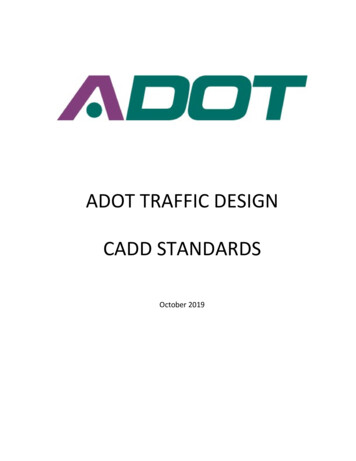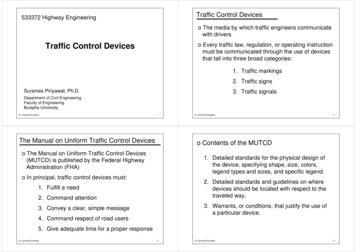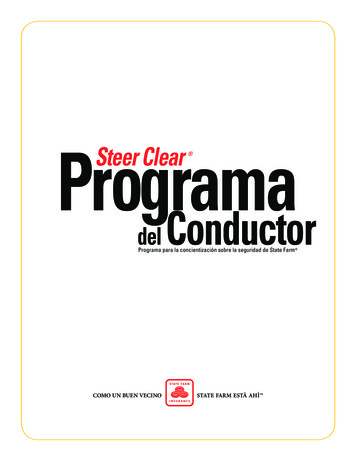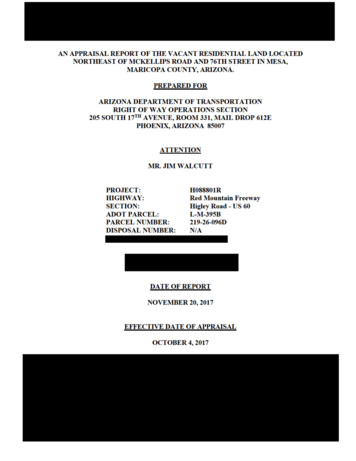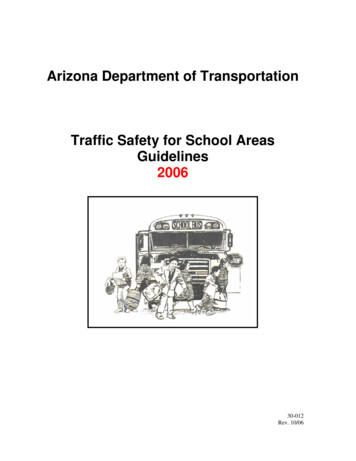
Transcription
Arizona Department of TransportationTraffic Safety for School AreasGuidelines200630-012Rev. 10/060
Arizona Department of TransportationTraffic Safety for School Areas GuidelinesTable of ContentsSectionTitlePage1Foreword22Arizona’s School Crossing History43Site Selection74On-Site Safety105Off-Site Safety146Safety at Existing School Sites167Arizona School Crossing Controls (Referred to as section 7.5in the AZ MUTCD Supplement)228Pedestrian Traffic Signals289Pedestrian Overpasses and Underpasses30AAppendix A – School Crossing Signs and Markings31BAppendix B – ADOT School Crossing Warrants42CAppendix C – A.R.S. 28-79747DAppendix D – Sample Application and OperatingAgreement for School Crossing48Appendix E – Sample Suggested Route to School Plan49E1
Section 1ForewordIn 1950, Arizona safety officials (police and engineers), in conjunction with parents and schoolofficials, created a unique traffic control concept that would slow motorists to 15 mph at schoolcrosswalks for the purpose of providing safe and efficient conditions near schools. This concept wasapproved and endorsed by the Arizona State Legislature (ARS 28-797).Shortly afterimplementation, it became apparent that compliance would improve and safer conditions wouldresult if guidelines were prepared. These guidelines would pinpoint the key components that wouldpromote uniformity throughout Arizona. Throughout this document, any reference to “SchoolCrossing” means the school crosswalk marked in yellow (except as noted in 28-797 F.1),accompanied by NO PASSING 15 MPH SCHOOL IN SESSION and STOP WHEN CHILDREN INCROSSWALK portable signs.These guidelines were first published in 1953 and this is the ninth known edition. The guidelines arepublished by the Arizona Department of Transportation (ADOT) and apply to the entire ArizonaHighway System. Since the majority of School Crossings are not on the state highway system, butinstead within local jurisdictions, ADOT has made it a practice to solicit and incorporate input fromlocal jurisdictions each time these guidelines are revised.Purpose and Applicability of ADOT GuidelinesThe purpose of these guidelines is to summarize the most successful ways of implementing ARS 28797 in order to effectively achieve school safety throughout Arizona. The guidance provided is fullyconsistent with the Manual on Uniform Traffic Control Devices and its companion ArizonaSupplement.These guidelines are applicable to school officials (public and private), school planners, trafficengineers, police, and other public safety personnel throughout Arizona. Engineering judgment iskey to achieving operational safety and efficiency around schools, carefully taking into considerationthe particular conditions that exist at each site. Engineers familiar with local conditions are in thebest position to assess and make engineering judgments regarding what will work best in a specificsituation.These guidelines are intended to promote community safety by harmonizing the efforts andresponsibilities of all involved. They are not intended to impose new or additional duties uponparents, schools, or jurisdictions operating streets and highways. Rather, the guidelines areintended to encourage all stakeholders to work together to make a difference in safety. Nationally,there has been a pattern of increased propensity for tort liability litigation. This has unfortunatelyresulted in some schools and jurisdictions becoming increasingly reluctant to act beyond minimalefforts to help create the safest practical school environment. This is not the intent or desire inArizona. Each party involved in school safety starts out with their own clear legal duties regardingtraffic safety as follows: Parents are primarily and personally responsible for their own children’s safety, health, andwelfare. This includes teaching children about crossing streets and driveways safely, ridingbikes safely, and other necessary precautions to take when traveling to and from school.Parents should know their children’s vulnerabilities. Schools are responsible for traffic safety on-site, much the same as operators of a movietheater, restaurant, or retail store. These duties can be extended if schools provide orcontract to provide portal to portal transportation, such as busing. In this case, schoolsaccept the duty for providing reasonable and safe transportation for children whom areprovided busing. Duties can also be extended when a school operates a School Crossing.Operation of a School Crossing requires the school to sign a written Operating Agreementconsistent with the intent of ARS 28-797 and these guidelines. The written OperatingAgreement specifies times of operation and whether adult crossing guards are required.2
State, county, and local jurisdictions have the ongoing duty to maintain a safe and efficientstreet system. Doing so requires jurisdictions to rely upon all road users to makereasonable, prudent, and lawful use of that street system. No traffic control device orparticular street design can compensate for illegal or imprudent use of the street by roadusers.Five decades of experience has proven that safety can be improved by each party complementingthe efforts of others. These guidelines recommend and encourage parents, schools, andjurisdictions to not just take responsibility for their own duties, but also to help one another.Depending on situations, budgets, priorities, and constraints: Parents can help by providing safety guidance for their own children and others as well.They can notify other parents, school officials, or jurisdiction officials of any safety concernsobserved. Parents and PTA groups can also provide additional adult oversight on routes toand from schools, apply adult judgment, pick appropriate gaps in traffic, make eye contactwith motorists before crossing a street, and help teach students to do the same. Schools can help promote safety education by sponsoring on-site presentations focusing onsafety. School officials can provide additional adult supervision on the busiest routes to andfrom schools. Adult crossing guards at designated crosswalks are to apply adult judgmentwhen picking gaps in traffic, watch for motorists to follow the “rules of the road”, and act asrole models when stepping into the street first as a responsible pedestrian when guidingschool children across the crosswalk. State, county, and local jurisdictions can help by sharing their expertise in traffic controlsafety, making educational videos and presentations, and helping to train adult crossingguards.School Safety: Perception Versus RealityTraffic control in school areas is a highly sensitive subject, creating a diverse range of opinionsabout the best potential applications. If all requests from citizens and parents were accommodated(additional police officers, adult guards, signals, flashing lights, signs, and markings), Arizona’sstreet and highway system would be non-functioning and not conducive to safety. In addition, suchdemands are seldom in line with actual needs and can create disrespect for warranted trafficcontrols, if implemented. Experience has shown that while doing more certainly costs more, it maynot always result in safer conditions and often can be counter-productive.It is important to stress that regardless of the school location, the safest and most effective trafficcontrol is achieved by the uniform application of realistic policies, practices, and standards based onsound engineering principles and engineering judgment. It is also important to keep in mind thattraffic control devices alone (signs, crosswalks, etc.) are powerless to overcome the root cause ofmost school related crashes. Most crashes result from the failure of the road users, both motoristsand pedestrians, to comply with the rules of the road and properly share the road space.3
Section 2Arizona’s School Crossing HistoryIn 1950, the Arizona State Legislature at the urging of traffic engineers, police, school officials, andparents passed legislation authorizing the use of the School Crossing concept on Arizona streets andhighways (ARS 28-797). The concept called for marking School Crossings in a different manner thannormal crosswalks by using yellow markings instead of standard white markings at pedestriancrossings and prohibiting passing on the approaches to the School Crossing. Additionally, the conceptis predicated on placing 15 mph portable speed limit signs in the roadway in advance of the crosswalkand STOP WHEN CHILDREN IN CROSSWALK portable signs at the crosswalk during the specifichours that each School Crossing is in effect and adult crossing guards were to provide supervision inmany cases.This concept recognized the following precepts: Aggressive enforcement is required to gain compliance of the 15 mph speed limit. School Crossings need to be limited in number, duration, and only used where truly needed. Ifused indiscriminately, motorists would ignore them and police could not adequately enforcethem. Schools will operate School Crossings by placing, removing, and re-setting portable signswhen knocked down. Schools will provide and train crossing guards. Adult Crossing Guards will help children learn to cross streets in a safe manner.On March 25, 1953, the creators of the School Crossing concept regrouped, having learned theimportance of standardizing practices. Their goal was to write a statewide guideline based on thesuccesses and failures of the concept. Experience showed that School Crossings should:Not be used at high schools: The 15 mph legislation originally addressed all schools. However, theconcept was not successful at high schools. There was consensus that continued use of SchoolCrossings at high schools threatened their effectiveness at elementary schools, where they were mostneeded. Not only did using School Crossings at high schools increase the number of SchoolCrossings, but older students failed to obey crossing guards, antagonized motorists, and in general,created substantial disrespect for the concept. Recognizing that high school students are generallyold enough know how to behave as responsible pedestrians and to even drive vehicles themselves, aconscious decision was made to treat high school students as other states do using traditionalmethods prescribed in Parts II, III and VII of the Manual on Uniform Traffic Control Devices.Not be used within 600 feet of a STOP sign, traffic signal, or another School Crossing on the samestreet: This outcome resulted from firsthand experience showing that motorist compliance with trafficcontrol was substantially reduced whenever a School Crossing was located too close to a STOP sign,traffic signal, or another School Crossing on the same street. Observations found that motoristsobeyed the first traffic control device, but consistently paid less attention to a second set of trafficcontrols unless they were separated by at least 600 feet. If another traffic control device exists that isclose to a proposed crossing location, it is best to either route the students to the other location, oralternatively, consider removing it so that an effective School Crossing can be employed nearby.Not be used in conjunction with STOP signs or traffic signals: These devices were all found to bemutually exclusive traffic control devices, for the above reasons.4
ARS 28-797 has been modified four times. Changes were made for the purpose of: Delegating authority to approve School Crossings from ADOT to local jurisdictions. Allowing School Crossings on unpaved roadways. Allowing use of School Crossings at signals, except at signals on state highways. Establishing doubled fines in school zones while school is in session.The allowance of school crossings on unpaved roads and at signals, while authorized by law underrare circumstances, is highly discouraged by practitioners based on both experience and safetyramifications. For example, if a School Crossing is installed on a dirt road, the crosswalk foregoes therecognition offered by the unique yellow pavement markings. Mixing traffic signals with the SchoolCrossing is discouraged for the following reasons: Signals work at conflicting purposes with School Crossings. The purpose of the traffic signalis to establish the right-of-way and provide orderly traffic progression at speeds consistent withthe roadway design. However, the purpose of the School Crossing is to slow traffic, allowingmotorists sufficient reaction time to stop for pedestrians at locations that do not offer thebenefit of either a STOP sign or a traffic signal. Red light violations may increase. Greater speed differential may occur through the School Crossing at a signal Added delay may promote risk-taking. Traffic may divert onto parallel residential streets as a by-product of motorists avoidingcongestion. The NO PASSING regulation creates confusion when motorists observe a green light. Portable signs at intersections with traffic volumes sufficient to warrant signals pose a directhazard to both pedestrians and motorists. Motorists looking up at signals may not expectmetal objects near where they may turn. Additionally, crossing guards may be at risk whenplacing and removing signs at busy signalized intersections. The portable STOP WHEN CHILDREN IN CROSSWALK sign conflicts directly with the greensignal which tells the motorist to go. Students or even adult crossing guards may feel they canenter the street against the DON’T WALK because of the priority to pedestrians created by aSchool Crossing.School Safety in Arizona TodayA key ingredient to Arizona’s success in school safety has been the early recognition of the dramaticdifferences in maturity levels of younger students (grades K-8) versus high school students.Experience has shown that older students are best treated using the standard pedestrian trafficcontrol prescribed in Parts II and III of the Manual on Uniform Traffic Control Devices (MUTCD),augmented by notification of the school grounds as prescribed in Part VII. High school students areat or near the age required to acquire a Driver License, so it is not surprising that success hasresulted from Arizona’s assumptions that high school students should be fully capable of crossingstreets using the basic “Rules of the Road” and the standard traffic control provided. Youngerchildren, on the other hand, have proven to benefit from the unique School Crossing/adult crossingguard concept described in these guidelines.The second key to achieving school safety in Arizona has been the recognition that optimum resultsare achieved by the application of engineering judgment by trained, accountable traffic officials5
familiar with local conditions. The traffic control device used must relate to the volume and speed oftraffic, street width, age (maturity level) of students, and the number of children crossing. For thisreason, the same traffic control application needed in a school area located directly on a majorhighway may be inappropriate on a residential street with low traffic volumes.Students of any age are expected to learn safe crossing procedures from their parents, who areresponsible for their behavior and progress. Good parenting, combined with schools providingeffective safety awareness opportunities and jurisdictions providing effective school traffic control, canenhance overall operations. Neither school children nor motorists can be expected to move safely inschool areas unless they obey the laws and respect the need for these controls. Reasonable,prudent, and lawful behavior is required by drivers and pedestrians alike to achieve a safeenvironment. Traffic control devices alone cannot compensate for unsafe behavior or decisions.It is important that traffic control in school areas be uniform throughout the state. Use of non-uniformprocedures or devices can confuse pedestrians and motorists, which in turn can lead to an increasedtendency for collisions. To promote uniformity, care needs to be taken before using some of themany optional traffic control devices contained in the MUTCD. While the MUTCD lists an abundanceof optional traffic control devices that “may” be used where justified by engineering assessments,many have shown little or no effect on traffic behavior near schools on Arizona streets and highways.Examples of these devices include posting unreasonably low speed limits, reduced speed limits withflashing lights, flashing warning lights, in-pavement lights outlining crosswalks, driver feedback signs,etc. Using these devices may work against uniformity in school areas, so should only be used whereunusual conditions exist warranting such devices. The use of additional devices is discouragedbecause engineering assessments by Arizona jurisdictions have found a majority of them to be1, 2ineffective in influencing speeds or crash rates . On a national scale, research has concluded thatan adverse consequence associated with using some of the devices is the increase in speedvariances, which can negatively impact safety.In summary, ARS 28-797 and the Arizona Supplement to the MUTCD together empower jurisdictionsto team with schools to use the highly successful School Crossing concept for children. The ArizonaSupplement to the MUTCD additionally mandates that traffic control used for K-8 schools comply withthese guidelines.“”2 School Zone Flashers- Do They Really Slow Traffic? ITE Journal, January 1990“”1 Pedestrian Warning Flashers in an Urban Environment, Do They Help? ITE Journal, January 19906
Section 3Site SelectionEffective site selection will enhance the safe and efficientmovement of vehicular and pedestrian traffic. Schoolsites and access to the sites should be tailored to fit localconditions.Planners should consider many factorsincluding: buses, parents, faculty, visitors, service ments, and emergency vehicles.A trafficengineer should be consulted before school layout plansare finalized and ideally before a site is even chosen.C. Size of the school structures (including projectionsfor growth)Traffic control and circulation around a potential schoolsite are some of the most important factors to beconsidered when selecting and designing a school siteplan. With proper site selection, potential traffic problemscan be eliminated or treated at the design stage. Thesuggestions in this guide need not be consideredexhaustive, since no guidelines can address allsituations.F. Size and shape of the school groundsThis chapter is intended for all personnel involved inlocating, designing, and operating new school facilities orin renovating and reconstructing existing facilities. Theguidelines can be applied to all school sites as part of aregular review to ensure that existing facilities are as safeas possible. Persons involved in school site planningand design should consult with local government andsafety agencies for assistance. State and local officialsshould be consulted regarding standards, codes,ordinances, and permits.The following design and traffic control principles areimportant and should be given the highest possiblepriority when evaluating new sites, expanding currentsites, or reviewing existing school operations.The present and future land use surrounding the schoolarea should be considered. For undeveloped areas,determine whether future development in the areawould complement a new school. Property zoned forresidential use is a good example of land usecomplementing a school area. In developed areas, aland use review would aid in determining appropriatelocations for school driveways. Estimate future trafficvolumes on abutting streets, review the need for trafficcontrol devices, and consider the need for pedestriancontrol prior to the design.The school district should establish the following designparameters before site selection and school design:D. Scope of extracurricular activities – playgroundarea, athletic fields, auditorium facilities,community rooms, etc.E. Current transportation policies in the school districtand public transit service availabilityG. Abutting and on-site roadway systems includingparking, loading zones, and accessibilityH. Proximity to high speed highways or arterial streetsthat would require crossing by school childrenOnce these elements are identified, the land areaneeded for the school site can be calculated by theschool architect and planner. Available sites areusually limited and, too often, the final selection isbased primarily on initial cost with only secondaryconsideration given to the parameters cited above.Such a selection, based on cost alone, isshortsighted and can prove costly in future years ifthe site does not have sufficient access forpedestrians or motor vehicles, sufficient area toaccommodate parent parking, future building andrelated facilities, and essential transportationfacilities.During initial stages, local authorities should becontacted to determine present and planned zoningand provide advice on how the site can bestfunction.The actual site location shouldconsideration of the following factors:dependonA. Amount of land and building space neededB. Zoning or land useC. Evaluation of land presently owned by the schooldistrictD. Funds available for land acquisitionE. Access to and impact upon street systemA. Current, projected, and maximum school populationB. Grades served (elementary, middle school, andhigh school)F. Classification of adjacent streets (local, collector,arterial, state highway, county primary, etc.)G. Relationship to other facilities7
H. Availability of utilitiesF. Adequate pedestrian and bicycle routes.I.Compatibility and partnering with adjacent landownersG. Bicycle racks.J.Future plans for expansionSchool sites should be selected to maximize thepotential for walking and bicycling and minimize theneed for motor vehicle transportation.Donated land and buildings or land presently ownedby the school district are not always suitable for anew school site. Increased travel times, busingneeds, accessibility, and land use problems will oftenmore than offset the initial dollar savings. A newschool is a long-term investment and should beanalyzed from that point of view.Traffic congestion and potentially hazardous conflictsmay develop if the site is not readily accessible froman adequate sidewalk and street network. Further, ifthe site is not adequate in size, it cannot efficientlyaccommodate all facilities necessary for effective andsafe school operations. The site size should besufficient to address all design considerations.Transportation elements that need attention during thesite selection and design phase include providing:A. Separate unloading/loading areas for studentstransported bySchool access is improved when the school isbounded by two or more streets. This allows forsufficient curb space to permit parent parking and/orbus loading. Providing sufficient access benefits bothvehicles and pedestrians. Smaller schools generallyexperience a higher percentage of students walking orbicycling to school, as opposed to a larger schoolcampus where more students travel longer distances.Typically, smaller schools pose lesser traffic andparking impacts on adjacent neighborhoods, especiallyduring special events.Elementary School SitesSchool sites which serve younger children should belocated as close as possible to the center of the areain which the students reside. This minimizes walkingdistances and reduces traffic congestion.Elementary school access is not compatible withlocations adjacent to arterial streets. The schoolshould be located on “collector” type roadways internalto neighborhoods, so as to minimize the need foryoung children to cross a major street on their way toschool. The ideal neighborhood school site will alsobe in the center of the attendance boundary with goodwalking access in all directions from the school.1. Faculty and staff.Streets adjacent to schools should be wide enough forsafe traffic flow. Curb parking should be prohibited inadvance of pedestrian crossings, at driveway areas,and at building entrances. These parking restrictionsmaximize visibility of school pedestrians and providesafer vehicle access. Elementary schools also tend togenerate the greatest number of driving parents, sospecial consideration should be given to provide ampleonsite queuing for parents picking up and dropping offstudents.2. Visitors.Middle Schools and Junior High School Sites3. Students (high schools only).Sites for middle and junior high schools typically havegreater capacities and attendance boundaries thanelementary schools which often results in greaterparking needs. This can make middle and junior highschools more difficult to accommodate withinneighborhoods. It is preferable that these schools belocated on “collector” roadways inside neighborhoodsrather than on arterials streets. They should also havewalking access on all sides of the school campus.Middle school and junior high school sites should bereadily accessible from a street system capable ofhandling school generated traffic (buses, servicevehicles, delivery trucks, and automobile traffic createdby faculty, staff, and parents). The use of local1. Parents.2. School bus.3. Public transit.B. Separated parking facilities forC. Access for1. Emergency vehicles.2. Service vehicles.3. Disabled persons.D. Sufficient roadways to avoid traffic congestion andthe concentration of activities at any one location.E. Analyses of playgrounds/athletic field locationsrelative to streets.8
residential streets for primary access to these schoolsshould be avoided.are to be considered, their installation should bepredicated on the responsible jurisdiction’s normalcriteria for crosswalk installation.High School SitesHigh school sites require special consideration for theirtransportation needs, especially vehicular access tothe site. High school sites are typically much largerthan elementary school sites.Because of size,associated traffic volumes, and the incompatibility withresidential land use, high schools are typically bestlocated on arterial streets.A good high school site design needs adequatearterial street access and on-site provisions for busand student loading. Student parking and associateddriveways should be separated from loading andunloading areas. Primary vehicle access to the schoolfrom local residential streets should be minimized.School Crossings should not be used for high schoolstudents. Instead, provisions outlined in Parts II, III,and VII of the MUTCD have proven to successfullyaccommodate high school students. It is important topreserve the integrity of the School Crossing so it cancontinue to provide its intended protection for youngerstudents.School administrators need to carefully evaluate themerits of an open campus. Allowing students to leavethe campus during the school day for lunch or breakperiods may unnecessarily expose students to safetyrisks linked with inexperienced drivers in a hurry toleave or return to campus.Charter School SitesCharter schools create unique traffic control andpedestrian issues that should be addressed by schooloperators. Many of these schools are located inbuildings or on sites that were not originally intendedor designed for school operations. Often, charterschools have few walking students, so SchoolCrossings may not be appropriate. However, if asufficient number of walking students exist and theschool requests a School Crossing, assessmentsshould be made in the same manner as at a traditionalpublic school.The assessment would take intoconsideration the age and number of pedestrians,conditions that exist, and a willingness by the charterschool to provide an adult crossing guard, whererequired.It is important that space be provided for buildings,recreation and athletic facilities, faculty and staffparking, visitor parking, student parking, bus loadingand student staging areas, bicycle racks, interiorroadways, etc.All School SitesAll schools are urged to consider future parking needs,especially student parking at high schools. It is best toevaluate the potential number of student vehicles andprovide adequate on-site space for them. Doing s. Inadequate on-site parking results inparking intrusion onto adjacent residential streets. Thisin turn can lead to congestion and safety concerns, aswell as complaints from nearby residents. Residentsnear schools often request parking restrictions, whichreduce the availability of off-campus parking. Schoolsshould not rely on parking that requires students tocross busy streets near the school.Overall, when all of these elements are considered,the final selection of a school site may have to bemade on the basis of compromise. Of the sitesconsidered, one may have adequate area, but limitedaccess; another may be accessible, but not providesufficient area for the desired facilities; still anothermay have many shortcomings, but be priced soattractively that it is given a preferential rating. In thelast case, it should be remembered that the long-termproblems that could result may well outweigh theshort-term price advantage. It is important for schoolauthorities to resolve these issues before a site isselected.Typically, most students arrive by car, meaning charterschools need to focus on providing adequate studentdrop-off and pick-up facilities in an area where thestudents do not need to cross streets. If public transitis used for student transportation, then the school mayneed to establish an adult guard system to overseeand assist the students. If standard (white) crosswalks9
Section 4On-Site SafetySchools have specific start and dismissal times, facultyand students typically arrive and depart atapproximately the same times. This creates the needfor efficient parking and drop-off/pick-up provisions. Itis important to provide adequate and separateprovisions for some functions, such as bus loading andstudent drop-off/pi
Traffic Safety for School Areas Guidelines Table of Contents Section Title Page 1 Foreword 2 2 Arizona's School Crossing History 4 3 Site Selection 7 4 On-Site Safety 10 5 Off-Site Safety 14 6 Safety at Existing School Sites 16 7 Arizona School Crossing Controls (Referred to as section 7.5 in the AZ MUTCD Supplement) 22

